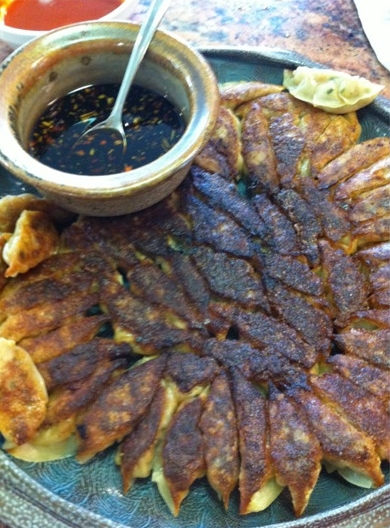They say that if you’re given lemons make lemonade. Twice in the past twelve months, I’ve been handed wonton skins to make pot stickers. Instead of pivoting to cook up wontons, I used the wonton skins to make pot stickers. I had to because I’d promised pot stickers to a client and a class. Local markets didn’t have pot sticker (gyoza) wrappers or the person in charge of shopping for me wasn’t clear on what was needed. After the initial 5 seconds of shock and panic, I took a breath and finessed the dumpling situation.
You may think, “What’s the big deal? A dumpling skin is a dumpling skin.” That’s not really true. There are differences in thickness and ingredients. Then there’s the filling itself. Pot sticker fillings are usually soft and very moist whereas wonton fillings are firmer, often times with cornstarch added for binding. Consequently, pot sticker wrappers are relatively thick whereas wontons skins are gossamer by comparison.
So what did I do in the face of a wet pot sticker filling and thin wonton skins? I punted with the following strategies:
Cut the square wonton skins into circles. Use scissors or a 3-inch (7.5 cm) biscuit cutter. Keep the wonton skins in short stacks to make the work go faster. At the class, the biscuit cutter was only 2 ¾-inches (7 cm) wide, which made filling them a bit
challenging.
Fill with less, a lot less. A thin wonton skin can’t handle a lot of the moist pot sticker filling, or the skin will get soggy. I told students to fill with about 1 to 1 ½ teaspoons of filling, leaving a good ¾-inch (2 cm) rim for closing up the rim. (You can fill store bought pot stickers skins with 2 teaspoons of filling; homemade wrappers can take 1 tablespoon of filling.)
Make the most simple
shapes. There was no room for fanciful shapes. Everyone made half moons, pea-pods or simple pleated crescents. Pot stickers made from wonton skins are delicate. Here's video of no-fuss pot sticker shapes that I made at Saveur magazine:
Dust the dumpling butts with extra flour. We had 2 cups of filling so that’s between 64 and 90 dumplings. To prevent the shaped dumplings from sticking while they sat uncooked, I had people dip the dumpling bottoms in extra flour. Instead of
parchment paper, my sous chef in class put down a Silpat-style non-stick baking sheet liner and sprinkled on flour too.
Pan-fry on lower heat. I used medium heat to brown the dumpling bottoms instead of medium-high heat because the skins are more delicate. Plus, we had so many to put into the skillet and I needed the extra time. There was a giant nonstick skillet so we crammed it full of dumplings and formed a sunflower of tiny pot stickers.
Add water cautiously. For steaming the pot stickers in the skillet, I used less water than usual at the front end, figuring that the thinner skin would require less moisture to cook. You can always add water but you can’t remove excess water all that easily!
Use a lid to unmold. I was going to flip the skillet to invert the pot stickers onto a platter but my sous chef and students suggested that I reconsider. There were many eyebrows raised as they wondered how successful I’d be handling the skillet. In the end, we decided to invert the dumplings onto a giant lid and slide them on the platter. It totally worked for a 16-inch (40-cm) wide sunflower of dumplings.
Explain to your guests? That’s up to you. In class and at my client’s location, everyone knew. We all marveled at the versatility of the dumplings as we ate every single one up.
Related posts:
- Wonton skin buying guide
- Wok Stickers: Original Pot Sticker Experiment
- Pot Sticker Duck Tacos (a nontraditional way to use a pot sticker wrapper)


















Yun Ho says
Hi Andrea:
Another way of simplifying the use of wonton skin to make pot stickers is to just fold the wonton skin into half and make rectangular-shaped pot stickers where cooking them in low heat will cause the crispy side to be browned nicely. Adding water in high heat will cook the filling and evaporate the water quickly.
Rectangular-shaped gyozas will eliminate any need to shape Wonton skins into a round shape. Use egg yolk as adhesive to bond skins together as it is more effective than water and you need not "ripple" the edges of the skin.
Cheers,
Barbara Lejeune says
Burned. Yuck.
Andrea Nguyen says
Sorry that you had burned food!